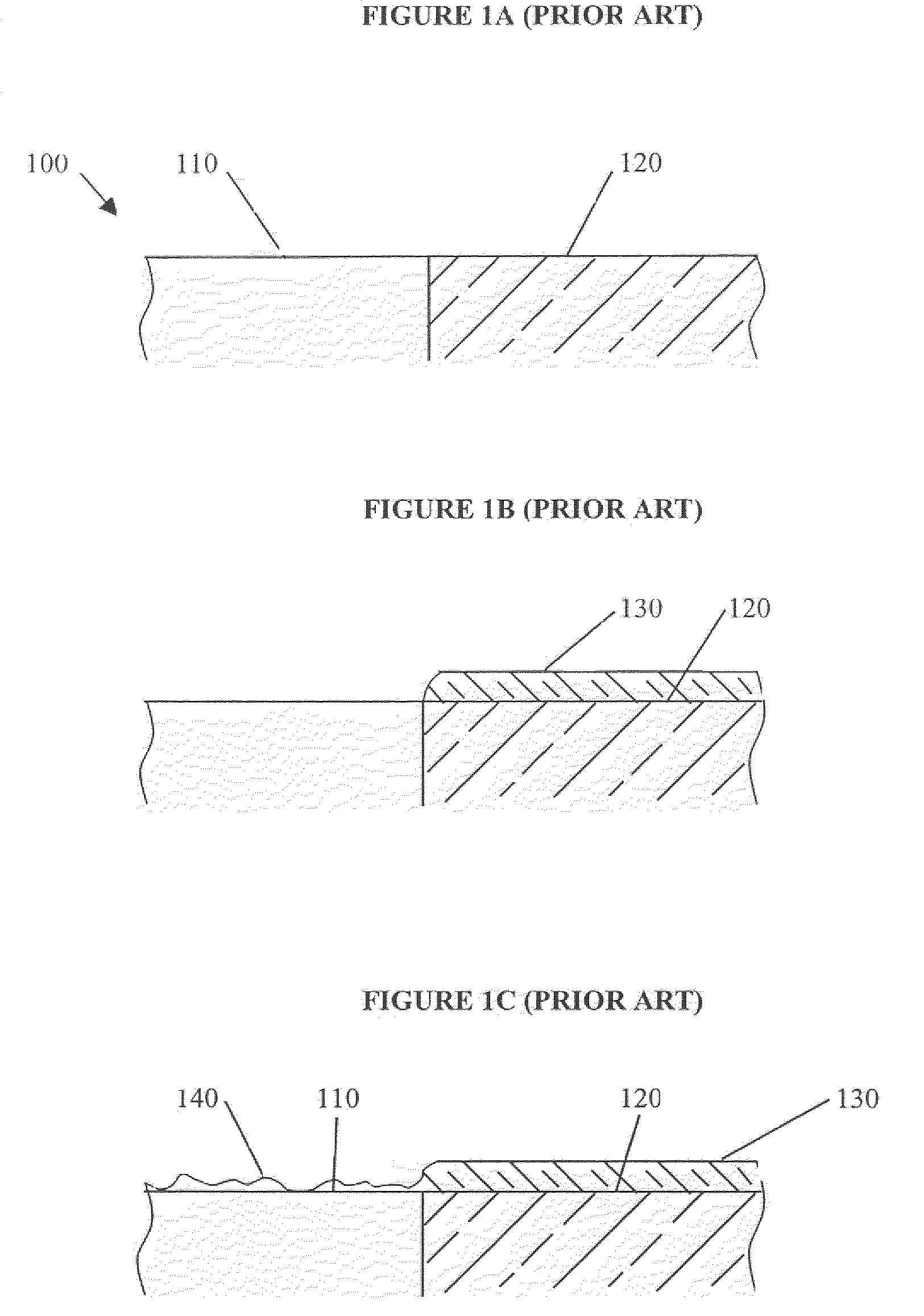Deposition Over Mixed Substrates
a technology of mixed substrates and silicon, applied in the direction of nanoinformatics, sustainable manufacturing/processing, final product manufacturing, etc., can solve the problems of difficult control, difficult control, and difficult control of deposition using these conventional silicon sources, and achieve the effect of reducing the number of steps
- Summary
- Abstract
- Description
- Claims
- Application Information
AI Technical Summary
Benefits of technology
Problems solved by technology
Method used
Image
Examples
example 1
[0066] A substrate was provided consisting of a 1500 SiO.sub.2 (oxide) coating deposited onto a Si(100) wafer. The substrate was patterned to remove about 20% of the oxide coating to expose the underlying Si(100) wafer, thus creating a mixed substrate having a single-crystal surface and an amorphous oxide surface. The mixed substrate was then etched in a solution of dilute hydrofluoric acid, rinsed and dried. The mixed substrate was then loaded into an Epsilon E2500.TM.reactor system and subjected to a hydrogen bake at 900.degree.C at atmospheric pressure under a flow of 80 slm of ultra-pure hydrogen for 2 minutes. The mixed substrate was then allowed to reach thermal equilibrium at 600.degree.C at 40 Torr pressure under a flow of 20 slm of ultra-pure hydrogen gas. The steps of etching, drying, rinsing, and baking rendered the single crystal surface active for epitaxial film growth.
[0067] Pure hydrogen gas was then passed through liquid trisilane (maintained at room temperature usin...
example 3
[0072] A Si-containing film was deposited at 600.degree.C as described in Example 2, but trisilane and germane were used in place of silane and germane as precursors. The surface roughness of the resulting SiGe film (as measured by atomic force microscopy) was 18.4 for a 10 micron x 10 micron scan area. SEM of the SiGe film revealed a much more uniform surface, as demonstrated in the SEM micrographs shown in Figures 8 and 9 (same magnifications and tilt angles as Figures 6 and 7, respectively). The relative lack of island-type deposition, as compared to silane, shows that deposition occurred evenly over the surface, and did not proceed by the nucleation and growth mechanism described above in Example 2. This illustrates the relative insensitivity of deposition to surface morphology when trisilane is used, i.e., excellent nucleation of trisilane-deposited layers and consequent smoothness.
examples 4-21
[0073] A series of Si-containing films were deposited onto a SiO.sub.2 substrate (without a nucleation layer) at a pressure of 40 torr using trisilane and germane. The trisilane flow rate was constant at 77 sccm (hydrogen carrier, bubbler) for the examples of Table 1. Germane flow (10% germane, 90% H.sub.2) and deposition temperature were varied as shown in Table 1. Germanium concentration (atomic %) and thickness of the resulting SiGe films were determined by RBS, and surface roughness was determined by atomic force microscopy (AFM). The results shown in Table 1 demonstrate that highly uniform films can be prepared over a range of temperatures and flow rate conditions, particularly over a range of germane concentration, and further illustrate the relative insensitivity of deposition to surface morphology when trisilane is used.
1TABLE 1 Deposition Temp. Germane Thickness Rate Roughness No. (.degree. C.) Flow (sccm) % Ge (.ANG.) (.ANG. / min) (.ANG.) 1 450 25 5.0 34* 8.5 3.2 2 450 50 7...
PUM
| Property | Measurement | Unit |
|---|---|---|
| temperature | aaaaa | aaaaa |
| thickness | aaaaa | aaaaa |
| temperatures | aaaaa | aaaaa |
Abstract
Description
Claims
Application Information
 Login to View More
Login to View More - R&D
- Intellectual Property
- Life Sciences
- Materials
- Tech Scout
- Unparalleled Data Quality
- Higher Quality Content
- 60% Fewer Hallucinations
Browse by: Latest US Patents, China's latest patents, Technical Efficacy Thesaurus, Application Domain, Technology Topic, Popular Technical Reports.
© 2025 PatSnap. All rights reserved.Legal|Privacy policy|Modern Slavery Act Transparency Statement|Sitemap|About US| Contact US: help@patsnap.com



